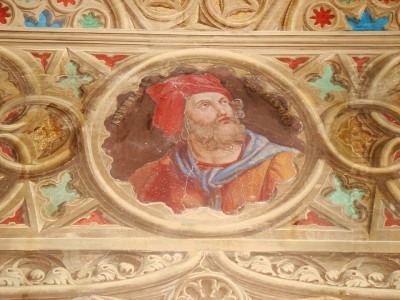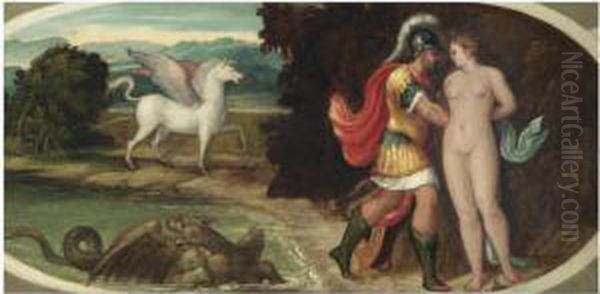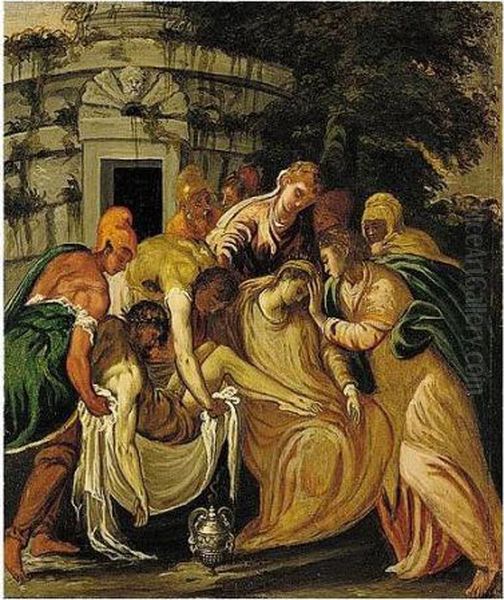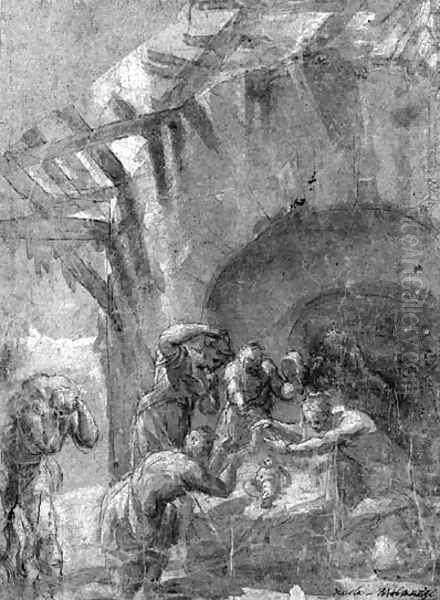
Andrea Meldolla, famously known as Andrea Schiavone (c. 1510/1515 – 1 December 1563), stands as a significant, if sometimes enigmatic, figure in the vibrant artistic landscape of 16th-century Venice. Born in the Venetian-controlled city of Zadar (Zara) in Dalmatia, now part of Croatia, his cognomen "Schiavone," meaning "the Slav," directly referenced his origins, a common practice in the cosmopolitan melting pot of Venice. His family, originally from the town of Meldola in Romagna, Italy, had relocated to Dalmatia, highlighting the fluid borders and interconnectedness of the Venetian Republic's territories. Schiavone's career unfolded primarily in Venice, where he carved out a unique niche as both a painter and a pioneering etcher, leaving an indelible mark on the Venetian School and the broader development of Mannerist art in Italy.
Early Life and Venetian Beginnings
Details surrounding Andrea Schiavone's early life and artistic training remain somewhat obscure, contributing to a certain mystique that surrounds his formative years. It is generally accepted that he arrived in Venice in the early 16th century, likely in the 1530s, seeking to establish himself in one of Europe's most dynamic artistic centers. Unlike many of his contemporaries whose apprenticeships under established masters are well-documented, Schiavone's path to artistic maturity seems to have been less conventional.
Some historical accounts, including those by early biographers like Carlo Ridolfi, suggest that Schiavone may have initially worked in a trade, possibly as a house painter or even in a carpenter's workshop. According to these narratives, he was largely self-taught in his initial artistic endeavors, dedicating his spare time to studying and copying the works of prominent masters. This period of intense self-study would have exposed him to the dominant artistic currents of the time. Venice was a crucible of artistic innovation, and young Schiavone would have had ample opportunity to absorb the lessons of its leading lights.

The city was then dominated by the towering figure of Titian (Tiziano Vecellio), whose mastery of color and dramatic composition set the standard. The lyrical and atmospheric qualities of Giorgione's (Giorgio Barbarelli da Castelfranco) work, though he had died earlier, continued to resonate. Furthermore, the influence of Central Italian art, particularly the burgeoning style of Mannerism, was beginning to permeate Venetian artistic circles, often through prints and drawings.
The Influence of Parmigianino and the Rise of Mannerism
A pivotal influence on Schiavone's developing style was the work of Parmigianino (Francesco Mazzola). This Emilian master, known for his elegant, elongated figures, sophisticated compositions, and refined sensuality, was a key proponent of early Mannerism. Schiavone likely encountered Parmigianino's art primarily through drawings and, significantly, through prints, which were instrumental in disseminating Mannerist aesthetics. He absorbed Parmigianino's penchant for graceful, attenuated forms, complex poses often employing the figura serpentinata (serpentine figure), and a certain artificial elegance that departed from the naturalism of the High Renaissance.
Schiavone did not merely imitate Parmigianino; rather, he synthesized these Mannerist tendencies with the rich colorism and painterly brushwork characteristic of the Venetian tradition. This fusion resulted in a distinctive personal style that was both innovative and deeply rooted in his adopted city's artistic heritage. Some sources suggest that Schiavone eventually entered the workshop of Titian or at least worked closely within his circle. While direct pupilage is debated, Titian's impact, particularly in terms of color, light, and compositional dynamism, is evident in Schiavone's mature works. He learned to combine the linear grace of Central Italian Mannerism with the Venetian emphasis on colore (color) and pittura di macchia (painting with patches of color).
Major Paintings and Commissions
Andrea Schiavone's reputation grew, leading to several important commissions for both private patrons and public institutions in Venice. Among his most notable achievements are the three large ceiling canvases, or tondi, painted around 1556-1557 for the antechamber of the Libreria Marciana (the Library of Saint Mark's). These works, depicting allegorical or mythological scenes, were part of a larger decorative project that involved other prominent Venetian artists, including Paolo Veronese, Giuseppe Salviati, and Battista Franco. Schiavone's contributions to the Libreria Marciana showcase his mature Mannerist style, characterized by elongated figures in dynamic, often contorted, poses, vibrant and sometimes acidic color palettes, and a sense of dramatic movement.

Another significant work often attributed to him is the triptych of "The Eternal Father with Angels," which further exemplifies his ability to handle complex compositions and imbue them with a spiritual intensity, filtered through a Mannerist lens. His oeuvre includes numerous religious and mythological subjects, such as "The Adoration of the Magi," "The Judgment of Midas," "The Conversion of Saul," and "The Holy Family with Saint Catherine and the Infant Saint John the Baptist." These paintings are marked by their fluid brushwork, rich textures, and a dramatic interplay of light and shadow that enhances the emotional impact of the scenes.
Schiavone's figures often possess a languid elegance, their limbs elongated and their gestures expressive, sometimes bordering on the theatrical. His compositions are frequently crowded and animated, creating a sense of visual energy. He was particularly adept at depicting luxurious fabrics and a shimmering surface quality, reflecting the Venetian love for opulent display. His color choices could range from deep, resonant hues reminiscent of Titian to brighter, more artificial combinations typical of Mannerism, sometimes employing shot silks and iridescent effects.
A Pioneer in Etching
Beyond his accomplishments as a painter, Andrea Schiavone was a highly innovative and influential printmaker, particularly in the medium of etching. He was one of the first Italian artists to fully explore the expressive potential of etching, moving beyond its initial use as a reproductive technique. His etchings are characterized by a remarkable freedom and spontaneity, often resembling spirited pen drawings with their flickering lines and bold, sketchy quality.
Schiavone produced a considerable body of around 130 to 140 etchings. Many of these were original compositions, while others were interpretations or variations of designs by other artists, most notably Parmigianino. His prints, such as "Saint Paul," "Perseus and Andromeda," "The Entombment," and "The Rape of Helen," demonstrate a mastery of the etching needle, achieving a wide range of tonal effects and textures. He experimented with different biting times to create variations in line depth and darkness, and he was known for his innovative use of surface tone, often leaving a film of ink on the plate to create atmospheric effects.
His approach to printmaking was highly experimental. He sometimes printed on colored paper, typically blue (carta azzurra), and occasionally hand-colored his impressions, further enhancing their painterly qualities. This experimental spirit set him apart and significantly contributed to the development of etching as an independent artistic medium in Italy. His prints were widely circulated and admired, influencing not only his Venetian contemporaries but also later generations of printmakers. Artists like Battista Franco, who also worked in Venice, and later figures in the Italian etching revival, such as Annibale Carracci and his followers, likely looked to Schiavone's bold graphic language.
Schiavone in the Venetian Art World

Andrea Schiavone operated within a fiercely competitive and incredibly rich artistic environment in mid-16th century Venice. The city was a hub of artistic production, with masters like Titian, Tintoretto (Jacopo Robusti), and Paolo Veronese dominating the scene. While Schiavone may not have achieved the same level of fame or monumental commissions as this triumvirate, he was a respected figure who contributed significantly to the diversity of Venetian art.
His embrace of Mannerism offered a distinct alternative to the more classical or naturalistic tendencies of some of his contemporaries. He shared with Tintoretto a penchant for dramatic compositions, dynamic movement, and elongated figures, though Tintoretto's energy was often more turbulent and his spiritual vision more intense. Veronese, by contrast, excelled in grand, decorative schemes characterized by luminous color and a sense of festive opulence. Schiavone's style, with its Parmigianino-esque elegance and Venetian color, occupied a unique space.
There is evidence of his interaction with other leading artists. For instance, Vasari mentions Schiavone in the context of the Libreria Marciana project, and it is recorded that in his later years, he was consulted alongside Titian and Veronese regarding the design for a mosaic in St. Mark's Basilica. This indicates his standing within the Venetian artistic community. He was also associated with figures like Jacopo Bassano, another prominent Venetian painter who developed a distinctive rustic genre style, and Paris Bordone, known for his rich color and often sensual mythological scenes. The artistic dialogues, rivalries, and collaborations among these artists fueled the dynamism of the Venetian School.
Artistic Style: A Fusion of Influences
Schiavone's artistic style is a fascinating amalgamation of Central Italian Mannerism and Venetian painterly traditions. From Mannerism, particularly as filtered through Parmigianino, he adopted the elongated proportions of figures, the graceful and often complex S-curve poses (figura serpentinata), and a sophisticated, sometimes artificial, elegance. His compositions often feature a shallow pictorial space, with figures arranged in dynamic, sometimes overlapping, groups. There's a sense of restlessness and emotional intensity in many of his works, characteristic of the Mannerist departure from the serene harmony of the High Renaissance masters like Raphael or the early Leonardo da Vinci.
From the Venetian tradition, Schiavone inherited a love for rich, vibrant color and a painterly application of pigment. His brushwork is often visible and expressive, contributing to the texture and dynamism of his surfaces. He masterfully handled light and shadow to model forms and create dramatic effects, a skill honed by studying Venetian masters. This ability to integrate the linear grace and intellectual sophistication of Mannerism with the sensuous appeal of Venetian color and light is the hallmark of his unique artistic identity. His work can be seen as a Venetian interpretation of Mannerism, distinct from its manifestations in Florence under artists like Pontormo (Jacopo Carucci) or Rosso Fiorentino, or in Rome.
Legacy and Posthumous Reputation
During his lifetime, Andrea Schiavone achieved a degree of recognition, securing important commissions and contributing to the artistic fabric of Venice. However, some contemporary accounts, including Vasari's, were somewhat critical, perhaps finding his style too unconventional or his drawing less rigorous than the Florentine ideal. Vasari, while acknowledging Schiavone's talent and industry, noted that he might have achieved greater perfection had he dedicated more time to drawing from life.
Despite such critiques, Schiavone's influence, particularly through his etchings, was significant. His innovative approach to printmaking helped to elevate the status of etching as an artistic medium and inspired subsequent generations of artists. His prints were collected and studied, and their impact can be traced in the work of later etchers, potentially extending as far as Rembrandt van Rijn in the Netherlands, who was an avid collector of Italian prints and whose own etching technique is characterized by a similar freedom and expressiveness. The Spanish-Greek master El Greco (Doménikos Theotokópoulos), who spent time in Venice around the period of Schiavone's death or shortly thereafter, would also have been exposed to his Mannerist style and Venetian color, which became foundational elements of El Greco's own unique vision.
It was perhaps after his death in Venice on December 1, 1563, that his reputation began to solidify more favorably, as art historians and collectors increasingly recognized the originality and importance of his contributions. He is now regarded as one ofthe leading exponents of Mannerism in Venice and a key figure in the history of Italian printmaking. His ability to synthesize diverse influences into a coherent and personal style, and his pioneering work in etching, secure his place in the annals of 16th-century European art. His works are found in major museums worldwide, testament to his enduring artistic significance.
Conclusion
Andrea Meldolla Schiavone was an artist of considerable talent and originality who navigated the complex artistic currents of 16th-century Venice with a distinctive vision. His Dalmatian origins and his somewhat unconventional path to artistic maturity perhaps contributed to his unique perspective. By masterfully blending the elegant artificiality of Central Italian Mannerism, particularly the influence of Parmigianino, with the rich colorism and painterly traditions of Venice, he forged a style that was both sophisticated and expressive.
As a painter, he contributed notable works to Venetian churches and public buildings, enriching the city's artistic heritage with his dynamic compositions and vibrant figures. As a printmaker, he was a true innovator, exploring the expressive capacities of etching with a freedom and technical experimentation that significantly advanced the medium. His legacy endures not only in his captivating paintings and spirited etchings but also in his influence on subsequent generations of artists who admired his bold synthesis of line, color, and emotion. Schiavone remains a compelling figure, a testament to the rich diversity and innovative spirit of the Venetian Renaissance.